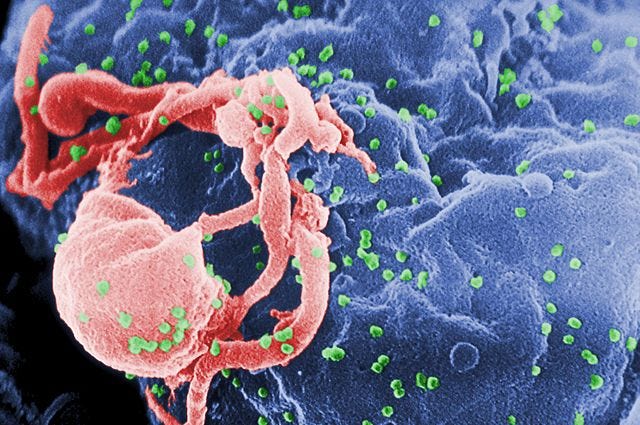Researchers Edit HIV Out of Immune Cells
March 23, 2016
Scientists have succeeded in cutting the virus responsible for AIDS out of cells in lab tests.
Brian Buntz
|
HIV image from Wikipedia. |
Scientists at Temple University Health System (Philadelphia, PA) have proclaimed that they may have a potential cure for patients infected with HIV. Using a custom gene editing system, the researchers have shown they can eliminate the virus from human cells in lab experiments.
Lead by professor Kamel Khalili, Ph.D., the researchers targeted HIV-1 proviral DNA using a guide RNA to home in one the HIV-1 DNA in the T-cell.
The researchers use a nuclease enzyme to cut strands of T-cell DNA. After the nuclease breaks the bonds of the HIV-1 DNA sequence, the frayed ends of the genome become reattached, the cell identifies that it is damaged and repairs it.
In an HIV infection, RNA is transcribed on the HIV-1 DNA and then is attached to a specific immune system known as CD4+ T cells. From there, the infected cells reproduce in the HIV genome, spawning new copies of the virus that then infect new CD4+ T-cells.
Khalili said that the technique could potentially be more effective at treating AIDS than antiretroviral drugs. While those drugs can control HIV infection effectively when taken regularly, patients with HIV infections can see "a rapid rebound in HIV replication" when they fail to take their drugs. If the levels of HIV reach a certain threshold, the patient gets full-blown AIDS.
While the number of AIDS has fallen significantly, dropping 42% from its 2004 peak, roughly 2 million people continue to become infected with the disease each year, according to UN AIDS. Some 25 million people have died from the disease since the virus was discovered in the early 1980s.
"They demonstrate the effectiveness of our gene editing system in eliminating HIV from the DNA of CD4 T-cells and, by introducing mutations into the viral genome, permanently inactivating its replication," Khalili said. "Further, they show that the system can protect cells from reinfection and that the technology is safe for the cells, with no toxic effects."
"The findings are important on multiple levels," Khalili said in a statement. "These experiments had not been performed previously to this extent," he added. "But the questions they address are critical, and the results allow us to move ahead with this technology."
In the research, the scientists used the controversial CRISPR technique, which Chinese scientists have tested for modifying human embryos.
Last year, MIT scientists claimed that they had advanced the accuracy of the technique, all but eliminating "off-target" editing errors that had previously been a drawback of the technique. The technology is quickly improving scientists' ability to edit the DNA of living cells.
The research was published in Scientific Reports.
Learn more about cutting-edge medical devices at BIOMEDevice Boston, April 13-14, 2016. |
Like what you're reading? Subscribe to our daily e-newsletter.
About the Author(s)
You May Also Like



